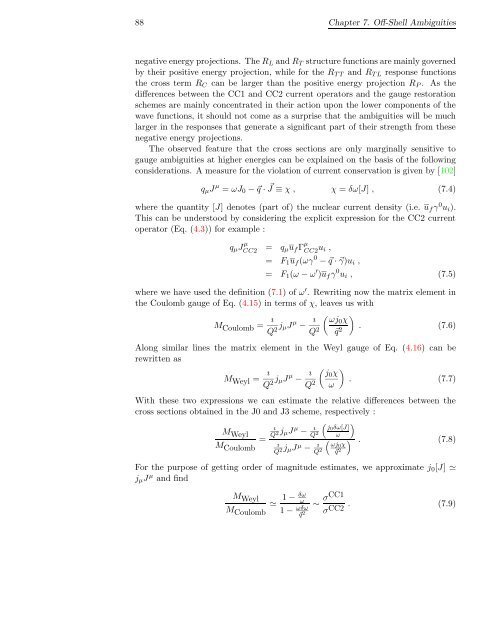Download Thesis in Pdf Format - Theoretical Nuclear Physics and ...
Download Thesis in Pdf Format - Theoretical Nuclear Physics and ...
Download Thesis in Pdf Format - Theoretical Nuclear Physics and ...
You also want an ePaper? Increase the reach of your titles
YUMPU automatically turns print PDFs into web optimized ePapers that Google loves.
88 Chapter 7. Off-Shell Ambiguities<br />
negative energy projections. The R L <strong>and</strong> R T structure functions are ma<strong>in</strong>ly governed<br />
by their positive energy projection, while for the R T T <strong>and</strong> R T L response functions<br />
the cross term R C can be larger than the positive energy projection R P . As the<br />
differences between the CC1 <strong>and</strong> CC2 current operators <strong>and</strong> the gauge restoration<br />
schemes are ma<strong>in</strong>ly concentrated <strong>in</strong> their action upon the lower components of the<br />
wave functions, it should not come as a surprise that the ambiguities will be much<br />
larger <strong>in</strong> the responses that generate a significant part of their strength from these<br />
negative energy projections.<br />
The observed feature that the cross sections are only marg<strong>in</strong>ally sensitive to<br />
gauge ambiguities at higher energies can be expla<strong>in</strong>ed on the basis of the follow<strong>in</strong>g<br />
considerations. A measure for the violation of current conservation is given by [102]<br />
q µ J µ = ωJ 0 − ⃗q · ⃗J ≡ χ , χ = δω[J] , (7.4)<br />
where the quantity [J] denotes (part of) the nuclear current density (i.e. u f γ 0 u i ).<br />
This can be understood by consider<strong>in</strong>g the explicit expression for the CC2 current<br />
operator (Eq. (4.3)) for example :<br />
q µ J µ CC2<br />
= q µ u f Γ µ CC2 u i ,<br />
= F 1 u f (ωγ 0 − ⃗q · ⃗γ)u i ,<br />
= F 1 (ω − ω ′ )u f γ 0 u i , (7.5)<br />
where we have used the def<strong>in</strong>ition (7.1) of ω ′ . Rewrit<strong>in</strong>g now the matrix element <strong>in</strong><br />
the Coulomb gauge of Eq. (4.15) <strong>in</strong> terms of χ, leaves us with<br />
M Coulomb =<br />
ı<br />
Q 2 j µJ µ −<br />
ı ( ) ωj0 χ<br />
Q 2 ⃗q 2 . (7.6)<br />
Along similar l<strong>in</strong>es the matrix element <strong>in</strong> the Weyl gauge of Eq. (4.16) can be<br />
rewritten as<br />
M Weyl =<br />
ı<br />
Q 2 j µJ µ −<br />
ı ( ) j0 χ<br />
Q 2 . (7.7)<br />
ω<br />
With these two expressions we can estimate the relative differences between the<br />
cross sections obta<strong>in</strong>ed <strong>in</strong> the J0 <strong>and</strong> J3 scheme, respectively :<br />
( )<br />
ı<br />
M Weyl j<br />
Q<br />
=<br />
2 µ J µ − ı j0 δω[J]<br />
Q 2 ω<br />
( ) . (7.8)<br />
M Coulomb<br />
ı<br />
j<br />
Q 2 µ J µ − ı ωj0 χ<br />
Q 2 ⃗q 2<br />
For the purpose of gett<strong>in</strong>g order of magnitude estimates, we approximate j 0 [J] ≃<br />
j µ J µ <strong>and</strong> f<strong>in</strong>d<br />
M Weyl<br />
M Coulomb<br />
≃ 1 − δω ω<br />
1 − ωδω<br />
⃗q 2<br />
∼ σCC1 . (7.9)<br />
σCC2















